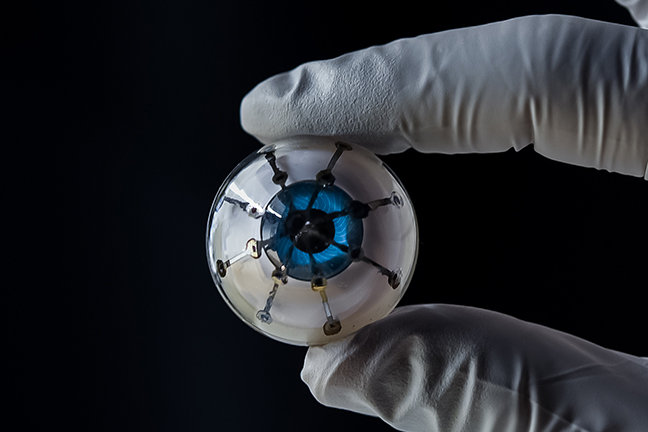The McAlpine Research Group from the University of Minnesota (UMN) has successfully 3D printed optoelectronic devices using polymer photodetectors on hemispherical surfaces. According to the research published in the latest edition of Advanced Materials, this is a significant step towards “bionic eyes” to aid the visually impaired.
“Bionic eyes are usually thought of as science fiction, but now we are closer than ever using a multi-material 3D printer,” said Michael McAlpine, an Associate Professor of Mechanical Engineering at UMN and leader of the McAlpine Research Group.

A 3D printed bionic eye
The McAlpine Research Group was formed to explore additive manufacturing, electronics, and biology integration on a single platform. Thus far, they have 3D printed temporary tattoos for potential healing applications, developed a prototype 3D printed living cell scaffold for spinal cord injuries, and an advanced 3D printer capable of creating “soft” robots.
McAlpine was personally driven to conduct research in creating a bionic eye as his mother has lost sight in one eye. With the collective experience of the McAlpine Group, the researchers began using its custom extrusion‐based 3D printer with a base ink of silver nanoparticles on a hemispherical glass dome. This initially demonstrated the possibilities of the printing on curved surfaces as the dispensed ink successfully stayed in place and dried consistently without seeping down into the dome.
Following this, the researchers printed high-performance polymer‐based photodetectors – which convert light into electricity – onto a PET film substrate within the hemispherical glass dome. The devices are integrated into image sensing arrays with high sensitivity and wide field of view. According to McAlpine, this process takes approximately an hour an is 25% more efficient than microfabricated semiconductors.
McAlpine explained that with 3D microfabrication techniques such as this, the 3D printed optoelectronic devices can be made with optimum design flexibility for next‐generation wearable and 3D structured optoelectronics.
An eye-opening experience
The McAlpine Group is now planning to create a prototype with more light receptors and improved efficiency. The researchers are also aiming to print on soft hemispherical materials that can be implanted into a real eye.
“We have a long way to go to routinely print active electronics reliably, but our 3D printed semiconductors are now starting to show that they could potentially rival the efficiency of semiconducting devices fabricated in microfabrication facilities,” explained McAlpine.
“Plus, we can easily print a semiconducting device on a curved surface, and they can’t.”
The research paper, “3D Printed Polymer Photodetectors ” is co-authored by Sung Hyun Park, Ruitao Su, Jaewoo Jeong, Shuang‐Zhuang Guo, Kaiyan Qiu, Daeha Joung Fanben Meng, and Michael C. McAlpine.
For more of the latest 3D printing news subscribe to the 3D Printing Industry newsletter and follow us on Twitter, and Facebook.
Pursuing a career in additive manufacturing or looking for skilled individuals in the field? Search and post 3D Printing Jobs for opportunities and new talent across engineering, marketing, sales and more.
Featured image shows the 3D printed optoelectronic “bionic eye” device. Photo via UMN/McAlpine Group.

